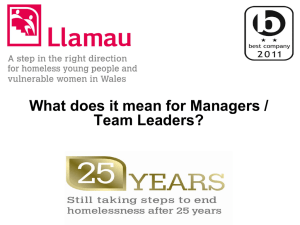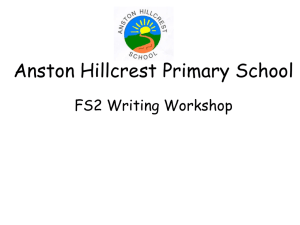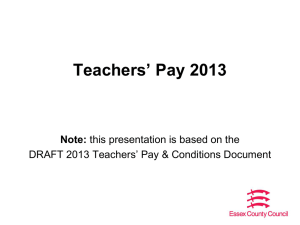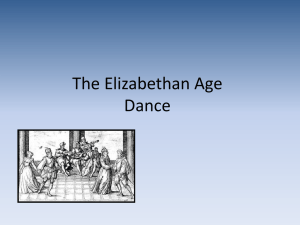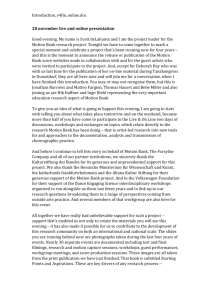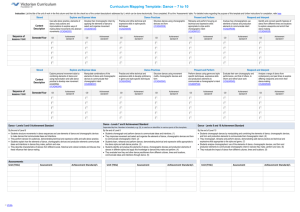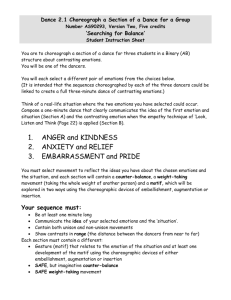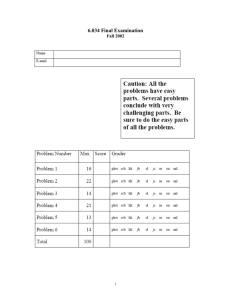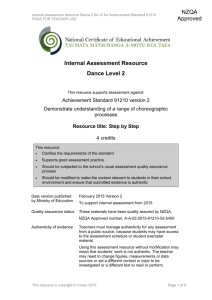Creative Movement in the Foundation Phase
advertisement
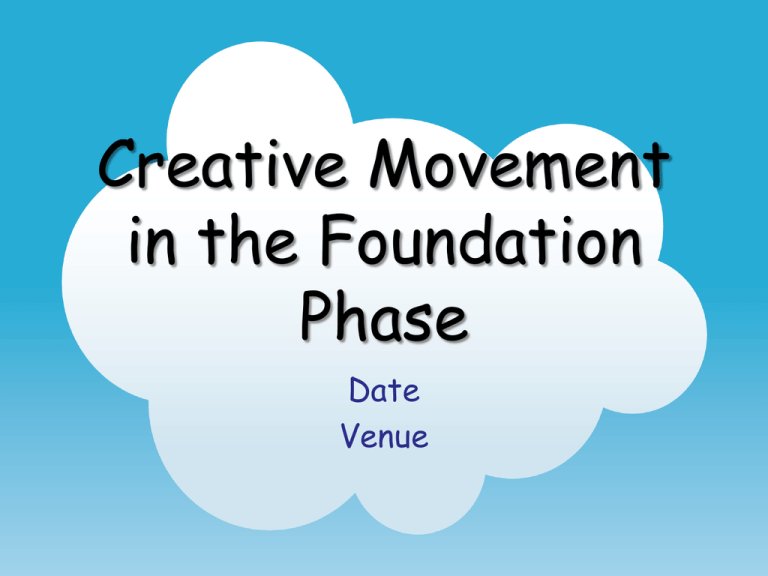
Creative Movement in the Foundation Phase Date Venue By the end of this course practitioners will have a basic knowledge and understanding of: • what Creative Movement is • the progressive stages for developing Creative Movement and Dance • effective planning and delivery – using a range of contexts and stimuli – to present opportunities for Creative Movement in continuous and focused provision – to present a range of stimulating opportunities for individuals, small groups, and whole classes, both indoors and out • the Creative Movement CD-ROM and resources By the end of this course practitioners will be able to: • improve children’s Creative Movement skills • identify how Creative Movement contributes to the requirements of the Foundation Phase • begin to identify how this approach can enhance existing practice • begin to compile a Creative Movement action plan Overview of course • Introduction • Aspects of Creative Movement – what, where, with, how and to what • Making Dances • Quality Learning and Teaching – Progression Maps – planning using Theme Cards and Progression Maps – RECIPE as an approach – evaluation, target setting and questioning • Action planning • Further information – Continuity and progression – Resource Overview • Plenary Introduction • The Big Picture • Links to ‘Play to Learn’ • Creative Movement within the Foundation Phase • Creative Movement Orders • What is Creative Movement? • Creative Movement can… The Big Picture The Foundation Phase: • is holistic in nature and based on the stage of the child’s development, not their age; • is child centred ; • must have a balance between structured learning through child-initiated activities and those directed by the practitioner; • must develop children’s self-image, feelings of self-worth and self-esteem as these are at the core of this phase; • places a greater emphasis on the outdoor environment as a resource; • should provide children with a broad balance and differentiated curriculum; • ‘Areas of Learning’ must complement one another and work together to provide a cross-curricular approach. They should not be approached in isolation; emphasis should be placed on developing children’s skills across the ‘Areas of Learning’; • must use Assessment for Learning; • must reflect the Skills Framework; • practitioners must understand, inspire and challenge children’s potential for learning. Links to ‘Play to Learn’ • Resource supports practitioners to provide opportunities for children to develop, apply, refine and adapt the technical skills introduced in ‘Play to Learn’; • Uses pictures to stimulate ideas for Creative Movement; • Many of the ‘Play to Learn’ Activity Cards and Stories can be used as a stimulus for Creative Movement; • Uses consistent terminology and concepts; • ‘Play to Learn’ audio CD’s can be used as a stimulus for Creative Movement or an accompaniment; • Resources are not lesson plans or unit plans but can be used as a springboard to stimulate further ideas that can be easily developed to provide differentiated learning experiences ; • Both consider progression in the same way: ‘As they develop’, ‘As they progress’ and ‘As they become more skilful’. Creative Movement within the Foundation Phase • 7 Areas of Learning – Personal and Social Development, Well-Being and Cultural Diversity – Language, Literacy and Communication Skills – Mathematical Development – Welsh Language Development – Knowledge and Understanding of the World – Physical Development – Creative Development • Creative Movement is part of Creative Development, together with Art, craft and design, and Music. Foundation Phase Orders Children’s creative movement skills should be fostered and promoted through using their senses, imagination and experience. Creative movement activities in the Foundation Phase should enable children to make progress in their ability to: • explore and express a range of moods and feelings through a variety of movements; • develop their responses to different stimuli such as music, pictures, words and ideas; • develop their control by linking movements to create a series of changing body shapes and pathways; • work on their own and with others to pretend, improvise and think imaginatively; • work on their own, with a partner or in a small group to develop their own and others’ ideas and help them to reflect on them; • perform movements or patterns, including some from traditional Welsh dances and from other cultures. Range Children should have opportunities to: • explore, investigate and use the indoor and outdoor learning environments; • be involved in different types of play and a range of planned activities, including those that are child initiated; • be involved in activities that allow them to work as individuals and in groups; • use a wide range of resources and stimuli; • experience traditions and celebrations of different cultures; • experience art, craft, design, music and dance from Wales and other cultures. What is Creative Movement? Why should children be given opportunities to develop their Creative Movement skills? Aspects of Creative Movement • • • • • What? Where? With? How? To What? What? Basic Dance Actions – Travel – Turn – Jump – Gesture – Stillness Where? – Direction – Level – Pathway – Spatial Awareness With? • With whom? – – – – Practitioner partner small group whole class • With What? – props How? – Dynamics • • • • Energy Flow Size Speed – Quality – Choreographic Devices To what? – accompaniment – improvisation Stimuli • Tactile – using a prop • Ideational – using concepts or issues • Kinaesthetic – using movement patterns • Auditory – using music, words, poems • Visual – using pictures, drawings, designs, video clips • Use of stimuli in learning environment and link to continuous provision Planning Focused Task Enhanced Provision Continuous Provision Supporting a child’s Learning Journey Making Dances - Developing Creative Movement ideas over several sessions - Individuals, pairs, small groups, whole-class dances - Dance structure – storyboard approach beginning, middle, end - RECIPE as an approach How - Choreographic Devices • Unison – same actions at the same time • Canon – Same actions but performed with a time delay, like a round in music • Repetition – repeat an action, several actions or a whole phrase N.B. Follow my Leader is not a separate Choreographic Device it is either Unison or Canon using a particular Spatial Arrangement i.e. One in front/one behind the other Quality Learning and Teaching • Progression Maps • Planning – using Theme Maps • Questioning • Evaluation and target setting Action Planning Identify: - short and medium term actions as a result of attending the Creative Movement course; - the success criteria you will use to measure the impact of the course on standards of learning and teaching; - what evidence will you collect to confirm this impact has been achieved; - how and to whom you will report progress/good practice. Further information • Continuity and progression • CD-ROM and resources Continuity and progression • Play to Learn • Making a Splash - Swimming in the Foundation Phase • Module 1, 2, 3 Gymnastic Activities • KS 2 Dance • Health, fitness and well-being • Role of the subject leader Plenary • Revisit course outcomes • Revisit action plan • Complete evaluation

